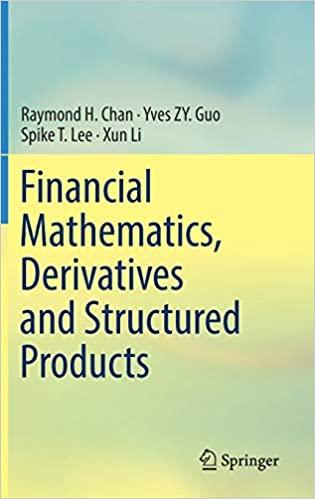
a) It has been observed that the put-call parity relation is often violated in practice - that is, Put price > Synthetic put price = Call price + Present value of strike price - Underlying stock price + Present value of dividends. In other words, if one buys the synthetic put by buying call, buying a risk-less bond that pays the strike price at the maturity, and short-selling the underlying stock and sells the put with the same strike price as the call option, she can make an arbitrage profit. Name TWO market frictions that would limit arbitrageurs from profiting from put-call parity violations and briefly explain. (4 marks) b) Kahneman and Tversky (1984) observe that risk seeking is prevalent when people must choose between a sure loss and a substantial probability of larger loss and some probability of smaller loss). Briefly explain how their VALUE function explains the phenomenon. (4 marks) c) You are about to regress the historical monthly excess returns of Google (RGoog) on the three Fama-French factors - Excess S&P 500 returns (R.m), SMB factor returns (SMB), and HML factor returns (HML). In other words, in each month t in your sample, you will run the following OL S regression: Rgoogle = a + B1Rm,t + B2SMB+ B:HML +& , where & is an error term in month t. What are the expected signs (+ or -) of the regression parameters a, B1, B2, and B3? Briefly explain. (4 marks) d) You found a public database for hedge fund returns and are eager to do some data analyses on hedge funds in general using the database. Your colleague found out that the hedge funds in the database were under no pressure to report their performance to anyone outside the funds. Based on her finding, she argues that the returns in the public data are likely to be biased upward. Would you agree? Why or why not? a) It has been observed that the put-call parity relation is often violated in practice - that is, Put price > Synthetic put price = Call price + Present value of strike price - Underlying stock price + Present value of dividends. In other words, if one buys the synthetic put by buying call, buying a risk-less bond that pays the strike price at the maturity, and short-selling the underlying stock and sells the put with the same strike price as the call option, she can make an arbitrage profit. Name TWO market frictions that would limit arbitrageurs from profiting from put-call parity violations and briefly explain. (4 marks) b) Kahneman and Tversky (1984) observe that risk seeking is prevalent when people must choose between a sure loss and a substantial probability of larger loss and some probability of smaller loss). Briefly explain how their VALUE function explains the phenomenon. (4 marks) c) You are about to regress the historical monthly excess returns of Google (RGoog) on the three Fama-French factors - Excess S&P 500 returns (R.m), SMB factor returns (SMB), and HML factor returns (HML). In other words, in each month t in your sample, you will run the following OL S regression: Rgoogle = a + B1Rm,t + B2SMB+ B:HML +& , where & is an error term in month t. What are the expected signs (+ or -) of the regression parameters a, B1, B2, and B3? Briefly explain. (4 marks) d) You found a public database for hedge fund returns and are eager to do some data analyses on hedge funds in general using the database. Your colleague found out that the hedge funds in the database were under no pressure to report their performance to anyone outside the funds. Based on her finding, she argues that the returns in the public data are likely to be biased upward. Would you agree? Why or why not







